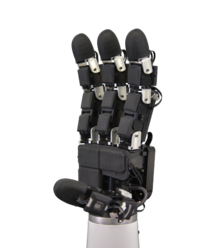Tactile sensor
For example, these sensors have been used in the manufacturing of automobiles (brakes, clutches, door seals, gasket), battery lamination, bolted joints, fuel cells etc.[4][5][better source needed] Tactile sensors can complement visual systems by providing added information when the robot begins to grip an object.Determining weight, texture, stiffness, center of mass, coefficient of friction, and thermal conductivity require object interaction and some sort of tactile sensing.Examples of such sensors available to consumers include arrays built from conductive rubber,[8] lead zirconate titanate (PZT), polyvinylidene fluoride(PVDF), PVDF-TrFE,[9] FET,[10] and metallic capacitive sensing[11][12] elements.A key exemplar is the Gelsight technology first developed at MIT which uses a camera behind an opaque gel layer to achieve high-resolution tactile feedback.[1] Recently, a sophisticated tactile sensor has been made open-hardware, enabling enthusiasts and hobbyists to experiment with an otherwise expensive technology.


cutaneous touchsensorsroboticscomputer hardwaresecurity systemstouchscreenmobile phonescomputingpiezoresistivepiezoelectricmanufacturingautomobilesgasketbatteryfuel cellsTactile imagingsensor arrayRobotsdexteritystiffnesscenter of masscoefficient of frictionthermal conductivitysimultaneous localization and mappingthin-filmconductive rubberlead zirconate titanatepolyvinylidene fluoridecapacitive sensingstrain gaugestwo-point discriminationvibrationopen-hardwareTactile technologyList of sensorsPressure measurementSensitivityTouch sensorTransducerBibcode